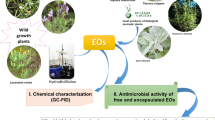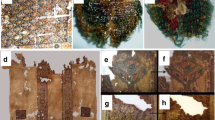Abstract
The study addresses in vitro degradation potential of airborne Aspergillus and Penicillium/Talarmyces species originating from cultural heritage conservation premises. A series of rapid, cost effective biodegradation assays were performed to assess production of extracellular pigments, acids, and enzymes. Most of the isolates have demonstrated positive growth in at least one of the preformed tests. Strongest overall degradation potential was demonstrated for Penicillium brevicompactum, P. glabrum, and Talaromyces sayulitensis while Aspergillus domesticus, A. penicillioides, A. pseudoglaucus, and A. ruber did not exhibit positive reaction in any of the employed assays. Majority of isolates exhibited proteolytic and cellulolytic activity while carbonate dissolution was observed for only five tested fungi. Highest alteration of pH value in liquid media was documented for T. sayulitensis while A. niger and P. expansum exhibited strongest acid production on CREA. Certain isolates, mostly Penicillium species, displayed production of extracellular pigments. The results imply that many of the tested fungi have significant biodegradation capacity, indicating their potential to inflict structural and esthetic alterations on cultural heritage objects.


Similar content being viewed by others
References
Albertano P, Urzì C (1999) Structural interactions among epilithic cyanobacteria and heterotrophic microorganisms in Roman hypogea. Microb Ecol 38(3):244–252
Anaya M, Borrego SF, Gámez E, Castro M, Molina A, Valdés O (2016) Viable fungi in the air of indoor environments of the National Archive of the Republic of Cuba. Aerobiologia 32(3):513–527
Arai H (2000) Foxing caused by fungi: twenty-five years of study. Int Biodeterior Biodegrad 46(3):181–188
Barad S, Horowitz SB, Moscovitz O, Lichter A, Sherman A, Prusky D (2012) A Penicillium expansum glucose oxidase–encoding gene, GOX2, is essential for gluconic acid production and acidification during colonization of deciduous fruit. Mol Plant Microbe In 25(6):779–788
Bartman CD, Doerfler DL, Bird BA, Remaley AT, Peace JN, Campbell IM (1981) Mycophenolic acid production by Penicillium brevicompactum on solid media. Appl Environ Microbiol 41(3):729–736
Borrego S, Perdomo I (2016) Airborne microorganisms cultivable on naturally ventilated document repositories of the National Archive of Cuba. Environ Sci Pollut Res 23:3747–3757
Borrego S, Guiamet P, de Saravia SG, Batistini P, Garcia M, Lavin P, Perdomo I (2010) The quality of air at archives and the biodeterioration of photographs. Int Biodeterior Biodegrad 64(2):139–145
Borrego S, Molina A, Santana A (2017) Fungi in archive repositories environments and the deterioration of the graphics documents. EC Microbiology 11(5):205–226
Burford EP, Fomina M, Gadd GM (2003) Fungal involvement in bioweathering and biotransformation of rocks and minerals. Mineral Mag 67(6):1127–1155
Dakal TC, Cameotra SS (2012) Microbially induced deterioration of architectural heritages: routes and mechanisms involved. Environ Sci Eur 24(1):36
Florian MLE (2002) Fungal facts: solving fungal problems in heritage collections. Archetype Publications Ltd., London
Frisvad JC, Smedsgaard J, Larsen TO, Samson RA, Robert A (2004) Mycotoxins, drugs and other extrolites produced by species in Penicillium subgenus Penicillium. Stud Mycol 49:201–241
Garg KL, Jain KK, Mishra AK (1995) Role of fungi in the deterioration of wall paintings. Sci Total Environ 167(1–3):255–271
Glass NL, Donaldson GC (1995) Development of primer sets designed for use with the PCR to amplify conserved genes from filamentous ascomycetes. Appl Environ Microbiol 61:1323–1330
Gutarowska B (2010) Metabolic activity of moulds as a factor of building materials biodegradation. Pol J Microbiol 59(2):119–124
Harkawy A, Górny RL, Ogierman L, Wlazlo A, Lawniczek-Walczyk A, Niesler A (2011) Bioaerosol assessment in naturally ventilated historical library building with restricted personnel access. Annal Agric Environ Med 18(2):323–329
Heberle H, Meirelles GV, da Silva FR, Telles GP, Minghim R (2015) InteractiVenn: a web-based tool for the analysis of sets through Venn diagrams. BMC Bioinformatics 16:169
Horton D (2012) Advances in carbohydrate chemistry and biochemistry, vol 68. Academic Press, Oxford, UK
Houbraken JA, Frisvad JC, Samson RA (2010) Taxonomy of Penicillium citrinum and related species. Fungal Divers 44(1):117–133
Jo WS, Bae SH, Cho DH, Park SD, Yoo YB, Park SC (2009) Optimal medium conditions for the detection of cellulolytic activity in Ganoderma lucidum. Mycobiology 37(4):313–316
Jones B, Pemberton SG (1987) The role of fungi in the diagenetic alteration of spar calcite. Can J Earth Sci 24(5):903–914
Liang YL, Zhang Z, Wu M, Wu Y, Feng JX (2014) Isolation, screening, and identification of cellulolytic bacteria from natural reserves in the subtropical region of China and optimization of cellulase production by Paenibacillus terrae ME27-1. Biomed Res Int 2014(512497):13
Lugauskas A, Krikŝtaponis A (2004) Microscopic fungi found in the libraries of Vilnius and factors affecting their development. Indoor Built Environ 13(3):169–182
Mandels M, Reese ET (1957) Induction of cellulase in Trichoderma viride as influenced by carbon sources and metals. J Bacteriol 73(2):269–278
Narasimha G, Reddi Pradeep M, Sridevi A (2016) Chemical pretreatment of agricultural feedstock for enhanced production of cellulase by mutant fungus, Aspergillus niger. J Appl Biotechnol Bioeng 1(1):00004
Nittérus M (2000) Fungi in archives and libraries. Restaurator 21(1):25–40
Nunes I, Mesquita N, Verde SC, Bandeira AML, Carolino MM, Portugal A, Botelho ML (2013) Characterization of an airborne microbial community: a case study in the archive of the University of Coimbra. Portugal Int Biodeterior Biodegrad 79:36–41
Nyuksha JUP (1994) The biodeterioration of paper and books. In: Garg KL, Garg N, Mukerji KG (eds) Recent advances in bodeterioration and biodegradation. Naya Prokash, Calcutta, India, pp 1–88
Onsori H, Zamani MR, Motallebi M, Zarghami N (2005) Identification of over producer strain of endo-β-1,4-glucanase in Aspergillus species: characterization of crude carboxymethyl cellulase. Afr J Biotechnol 4(1):26–30
Ortega-Morales BO, Narváez-Zapata J, Reyes-Estebanez M, Quintana P, De la Rosa-García S, Bullen H, Gómez-Cornelio S, Chan-Bacab MJ (2016) Bioweathering potential of cultivable fungi associated with semiarid surface microhabitats of Mayan buildings. Front Microbiol 7:201
Pangallo D, Chovanova K, Šimonovičová A, Ferianc P (2009) Investigation of microbial community isolated from indoor artworks and air environment: identification, biodegradative abilities, and DNA typing. Can J Microbiol 55(3):277–287
Pangallo D, Kraková L, Chovanová K, Šimonovičová A, De Leo F, Urzì C (2012) Analysis and comparison of the microflora isolated from fresco surface and from surrounding air environment through molecular and biodegradative assays. World J Microbiol Biotechnol 28(5):2015–2027
Pasqariello G, Valenti P, Maggi O, Persiani AM (2008) Paper. In: Caneva G, Nugari MP, Nugari MP, Salvadori O (eds) Plant biology for cultural heritage: biodeterioration and conservation. Getty Conservation Institute, Los Angeles, pp 108–113
Pasquariello G, Maggi O, Persiani AM (2008) General processes of biodeterioration of materials of plant origin. In: Caneva G, Nugari MP, Nugari MP, Salvadori O (eds) Plant biology for cultural heritage: biodeterioration and conservation. Getty Conservation Institute, Los Angeles, pp 99–100
Pinna D, Salvadori O (2008) Processes of biodeterioration: general mechanisms. In: Caneva G, Nugari MP, Nugari MP, Salvadori O (eds) Plant biology for cultural heritage: biodeterioration and conservation. Getty Conservation Institute, Los Angeles, pp 15–34
Pinzari F, Cialei V, Barbabietola N (2010) Measurement of the fungal deteriorating potential in the dust of indoor environments. E-Preserv Sci J 7:29–34
Rojas TI, Aira MJ, Batista A, Cruz IL, González S (2012) Fungal biodeterioration in historic buildings of Havana (Cuba). Grana 51(1):44–51
Samson RA, Hoekstra ES, Frisvad JC (2004) Introduction to food-and airborne fungi. Centraalbureau voor Schimmelcultures (CBS), Utrecht, The Netherlands
Samson RA, Houbraken J, Thrane U, Frisvad JC, Andersen B (2010) Food and indoor fungi, CBS laboratory manual series. CBS-Fungal Biodiversity Centre, Utrecht, The Netherlands, p 2
Saran S, Isar J, Saxena RK (2007) A modified method for the detection of microbial proteases on agar plates using tannic acid. J Biochem Biophys Methods 70(4):697–699
Savković Ž, Unković N, Stupar M, Franković M, Jovanović M, Erić S, Šarić K, Stanković S, Dimkić I, Vukojević J, Ljaljević Grbić M (2016) Diversity and biodeteriorative potential of fungal dwellers on ancient stone stela. Int Biodeterior Biodegrad 115:212–223
Scheerer S, Ortega-Morales O, Gaylarde C (2009) Microbial deterioration of stone monuments—an updated overview. Adv Appl Microbiol 66:97–139
Shivani D, Kumar JS (2015) Extracellular enzymatic profile of fungal deteriogens of historical palace of Ujjain. Int J Curr Microbiol App Sci 4(5):122–132
Sterflinger K (2000) Fungi as geologic agents. Geomicrobiol J 17:97–124
Sterflinger K (2010) Fungi: their role in deterioration of cultural heritage. Fungal Biol Rev 24(1–2):47–55
Teather RM, Wood PJ (1982) Use of Congo red-polysaccharide interactions in enumeration and characterization of cellulolytic bacteria from the bovine rumen. Appl Environ Microbiol 43(4):777–780
Unković N, Dimkić I, Stupar M, Stanković S, Vukojević J, Ljaljević Grbić M (2018) Biodegradative potential of fungal isolates from sacral ambient: In vitro study as risk assessment implication for the conservation of wall paintings. PLoS One 13(1):e0190922. https://doi.org/10.1371/journal.pone.0190922
Viegas C, Pinheiro AC, Sabino R, Viegas S, Brandão J, Veríssimo C (2015) Environmental mycology in public health: fungi and mycotoxins risk assessment and management. Academic Press, Cambridge, Massachusetts, USA
Visagie CM, Hirooka Y, Tanney JB, Whitfield E, Mwange K, Meijer M, Amend AS, Seifert KA, Samson RA (2014) Aspergillus, Penicillium and Talaromyces isolated from house dust samples collected around the world. Stud Mycol 78:63–139
de Vries RP, Visser J (2001) Aspergillus enzymes involved in degradation of plant cell wall polysaccharides. Microbiol Mol Biol R 65(4):497–522
Wainwright M (1999) An introduction to environmental biotechnology. Springer, Boston, MA
Warscheid T, Braams J (2000) Biodeterioration of stone: a review. Int Biodeterior Biodegrad 46(4):343–368
White TJ, Bruns T, Lee S, Taylor JW (1990) Amplification and direct sequencing of fungal ribosomal RNA genes for phylogenetics. In: Innis MA, Gelfand DH, Sninsky JJ, White TJ (eds) PCR protocols: a guide to methods and applications. Academic Press, New York, pp 315–322
Yilmaz N, Visagie CM, Houbraken J, Frisvad JC, Samson RA (2014) Polyphasic taxonomy of the genus Talaromyces. Stud Mycol 78:175–341
Funding
This research was carried out as a part of the project No.173032 financially supported by the Ministry of Education, Science and Technological Development of the Republic of Serbia.
Author information
Authors and Affiliations
Corresponding author
Additional information
Communicated by: Lukasz Stepien
Publisher’s note
Springer Nature remains neutral with regard to jurisdictional claims in published maps and institutional affiliations.
Rights and permissions
About this article
Cite this article
Savković, Ž., Stupar, M., Unković, N. et al. In vitro biodegradation potential of airborne Aspergilli and Penicillia. Sci Nat 106, 8 (2019). https://doi.org/10.1007/s00114-019-1603-3
Received:
Revised:
Accepted:
Published:
DOI: https://doi.org/10.1007/s00114-019-1603-3




